Ever wondered what it’s like to drive an ambulance through the busy streets of Pinellas County? Operating a high-tech ambulance weighing in at more than five tons is a lot different than driving your everyday sedan or SUV. Add the fact that operators must ensure the safety of their patients and surrounding drivers, and you can see why training to drive an ambulance is serious business. That’s why Sunstar has people like emergency vehicle operations course (EVOC) instructor Greg Moran.
Moran, an education and training coordinator at Sunstar, trains ambulance operators to navigate local roads and highways while providing patients the best experience possible under the circumstances. Bringing more than 20 years of teaching experience to his post, Moran has been with Sunstar since 2000 and has been an instructor since 2004.
He says that EVOC is “all about the patient. We want the unit and the crew to give a successful experience to the patient. Our goal is to keep that environment as safe and as comfortable as possible.”
It takes a lot to reach that important goal. EVOC entails 16 intensive hours of training over two days, covering everything from tire safety to defensive driving to the fine points of Florida law. Charlene Cobb, Sunstar’s community outreach coordinator, explains that Moran and his fellow instructors do everything they can to ensure their trainees’ success, including working with the trainees for a week to build their skills and confidence before they begin the course.
Drivers spend the first day of the course in the classroom learning about the core elements of safely operating an emergency vehicle. The classroom day provides trainees with a solid foundation from which they can build the rest of their skills. But many aspects of ambulance operation can’t be learned without practical experience behind the wheel. That’s why, on the second day of EVOC, drivers get to apply their training in hands-on exercises in the ambulance—and that’s where things really get tough.
In the first place, the cab of an ambulance is a lot more complicated than even the newest models of passenger cars. “It’s like a cockpit,” says Moran. “When you look at an aircraft cockpit and it has lots of buttons and knobs, it’s like that. There are multiple radios to manage, lots of buttons to learn, different ways to turn things on turn things off … there’s quite a bit to it, just inside the cab.”
After the trainees familiarize themselves with the inner workings of the ambulance’s cab, they practice skills including obstacle avoidance, smooth transitions between lanes, and smooth stops. Two of the more difficult skills they must master are the serpentine and the six-point star. The serpentine involves zigzagging through cones both forwards and backwards and is used to familiarize drivers with the way the ambulance moves and the safest ways to use the mirrors. The six-point star, which Moran says is even more challenging, is something like a more complicated three-point turn, involving pulling forward and backward into tight situations. Skill in the six-point star helps drivers maneuver their oversized emergency vehicles into tight places—such as an emergency room loading bay or trailer park—without harming any structures, people or vehicles.
Another test is more challenging, reportedly also more thrilling. In this test, the drivers (in a controlled environment) purposely hydroplane and are taught to recover safely. The training involves a special “skid pad” set up to mimic a wet road. During the training, drivers experience three different types of skids and learn how to safely recover from them. Moran says that this aspect of the training focuses on “teaching them not to panic and how to better manage the situation.”
A large proportion of the training deals with interacting safely with other drivers on the road. In an ideal world, other drivers would always react in accordance with safety and applicable law when an ambulance approaches with lights and sirens on. In reality, that’s not always what happens—so ambulance drivers must be able to focus and exercise situational awareness.
“We want to be proactive and give other drivers time to react; we teach our drivers to be aware of that,” says Moran. He says that drivers must learn to leave a safe following distance from others on the road, to be aware that visitors from other states may not be familiar with Florida’s “pull to the nearest curb for emergency vehicles” rule, and more. “The emphasis is safety, safety, safety,” Moran adds.
EVOC is only part of the rigorous training emergency medical technicians (EMTs) and paramedics receive. They also receive 45 to 60 day internship from field training officers and preceptors and clearance before drivers go out on their own. And even after drivers are fully trained and certified to handle calls, a high-tech support and monitoring system helps ensure that they continue follow their training and standard operating procedures (SOPs).
One part of that system is the “Road Safety” that they have to drive with. It’s a tool like the black box on an airplane that tells the drivers in real time if their stops are too hard, or their speed above the allowable limit, and even reminds them to wear their seatbelts. The “black box” also provides feedback about these things to Sunstar leadership and trainers like Moran so that they know whether any given driver needs help or additional training. “We use it as a tool for success,” he explains.
Instructing new ambulance operators is serious work, and can be intense, but Moran says that interacting with people and seeing them smile when they succeed makes all the work worth it.



